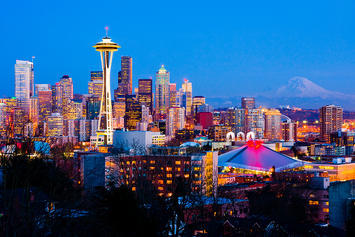
The recent wrangling over decisions on where to build the next version of Boeing’s 777 has left a residue of bitterness and rancor around the Puget Sound region. Were the Machinists forced to give too much? Were the taxpayers squeezed too far? While views will differ on those questions, one thing is clear: jobs lost at Boeing are very difficult, if not impossible to replace.
In the Seattle region we can easily forget how insanely fortunate we are to have Boeing Commercial Airplanes located here. As much as we love to talk about software, gaming, life sciences, internet commerce and other 21st century industries, Seattle owes its status as a large and prosperous metropolitan area almost entirely to the economic base established by Boeing fifty years ago.
And if we can avoid becoming another San Francisco, with high levels of income inequality, outrageous housing prices, a shrinking middle class and a consequent increase in social tensions, we will owe Boeing for that too.
Maybe we paid too much for the 777. But the alternative – Puget Sound minus Boeing – is a frightening idea. Ever since the Boeing Bust of 1969, Seattle area leaders have been trying to diversify the region's manufacturing economy, and with few major successes. The reason for this is obvious: our location in the upper left hand corner of the map.
Manufacturing industries tend to locate near their customers and suppliers to minimize transportation costs. Puget Sound is simply too far from national markets to make sense as a location for heavy industry. By the 1950s, the region had maxed out its potential in timber, fishing and shipping, and the economy stagnated. The manufacturing boom that followed World War II largely passed the region by, and in 1957 a prominent businessman accurately described the Northwest as "America's most important colony."
Then came Boeing's entry into the commercial jet aircraft business. Prior to World War II Boeing had served as a sort of R&D shop for the U.S. government, developing innovative military and airmail planes that never sold very well. Boeing developed the first modern commercial transport, the 247, which was immediately eclipsed by the Douglas DC-3. Boeing had some commercial success, but was still a minor player in the propeller age.
After World War II the military stopped buying B-17 and B-29 bombers, for obvious reasons, and Boeing fell into a slump. It gradually revived itself with the successful B-47 and B-52 jet bomber programs. But it was another military program--developing a jet powered refueling tanker that could keep up with the new jet bombers--that was the key. That tanker airframe was repurposed into the 707, an aircraft that revolutionized civilian air transport and led to the transformation of the Puget Sound economy.
With commercial jet aircraft factories, the region finally had a large, scalable manufacturing industry that did not depend on low transportation costs. In fact, the products deliver themselves! With the success of the 707 Boeing began a very aggressive strategy, launching four new airplane programs during the 1960s: the 727, 737, 747 and the ill-fated SST. Before the bust of 1969, Boeing employed well over 100,000 people in the region, accounting for nearly all the net job growth of the decade.
Since then, Boeing's Puget Sound area employment has fluctuated between 60,000 and 110,000. And although it is gradually shrinking as a share of the economy, Boeing provides one thing that fewer and fewer industries can offer: large numbers of secure, high-paying blue collar jobs. Boeing investments are measured in decades, and even with recent give-backs, the machinists enjoy a very nice compensation package. The layer of middle class employment at Boeing is what makes the Puget Sound region different from San Francisco, and holds the line against our evolution into a Superstar City.
Yes, Boeing's tactics have wounded pocketbooks and left a bad taste in the region's mouth. And its status as a largely Midwestern company (just try to find any Northwest connections on its board) further diminishes the emotional tie. But we cannot lose sight of the value it brings. There is simply no better industry around which to build a regional economy and we are incredibly lucky to have it here. So we'll swallow some pride and hold tight to a company that every region in the world would kill to get its hands on.
The Seahawks 12th Man paint job that Boeing workers put on a brand new 747 freighter just before the Super Bowl brought back a glimpse of the Boeing connection that we used to take for granted. The challenge for Boeing and for regional leaders is to rebuild that connection. In Seattle we will always live in the "Jet City."
Michael Luis is a consultant in public affairs and communications, based in the Seattle area, and is the author of Century 21 City: Seattle’s Fifty Year Journey from World’s Fair to World Stage. He also serves as councilmember and Mayor of the city of Medina, Washington. He can be reached at luisassociates@comcast.net.
Seattle photo courtesy of BigStockPhoto.com.












